Avakaya Recipe (Avakai Pickle)
Updated: April 25, 2023, By Swasthi
Avakaya is a popular Mango Pickle variety from Andhra Cuisine. Made with raw upripe green mangoes, spices and garlic, Avakai is spicy, hot, sour and pungent with a tongue tickling taste that awakens the taste buds. Avakaya is a condiment eaten with almost every meal in traditional Telugu speaking homes. In this post I share the traditional way to make the most popular Andhra Avakaya which you can preserve for a year.
Indian cuisine is diverse and there are numerous ways to prepare every dish. Mango Pickle is made in so many ways across India and every version tastes so much different from the others. Avakaya is from Andhra Cuisine, a Southern Indian cuisine that is synonymous to hot and spicy foods.
About Avakaya
The term “Avakaya“, is a blend of two words, where “ava” means “Mustard” and Kaya means “Raw uncooked fruit or vegetable”. In this context it means – raw mangoes with mustard. Basic Avakai is made by simply mixing fresh cut mango pieces with mustard powder, red chilli powder, methi seeds, salt and oil. A lot of people also add garlic and ground methi for a unique flavor.
The prepared mixture is stored in carefully cleaned and sun dried ceramic jars for 3 days. On the 4th day, the pickle is mixed before it goes into the dry cabinet for yearlong preservation.
Making Avakaya is a culinary tradition that has been passed down over generations in every family. Every summer, Telugu speaking homes make this pickle with a lot of excitement and love. A typical everyday Andhra meal is served with avakai. So most families make this in large quantities to last for an year.
The process of making avakai is simple but since it is made in large quantity the pickling process becomes a tedious task. My mom would always make this with 75 to 100 mangoes. I carry a portion of avakai every time I travel back from India. This time I thought of sharing my Mom’s recipe.
There are close to 6 to 8 variations of avakaya, like
- Bellam avakaya – made with jaggery
- Menthi avakaya – with a higher quantity of methi powder
- Endu avakaya – made with sun dried mangoes.
Each version tastes different and has a different flavor. A lot of people make the basic avakaya in large quantity and the others in smaller quantities.
More pickle recipes
Lemon Pickle
Carrot Pickle
Andhra Tomato Pickle
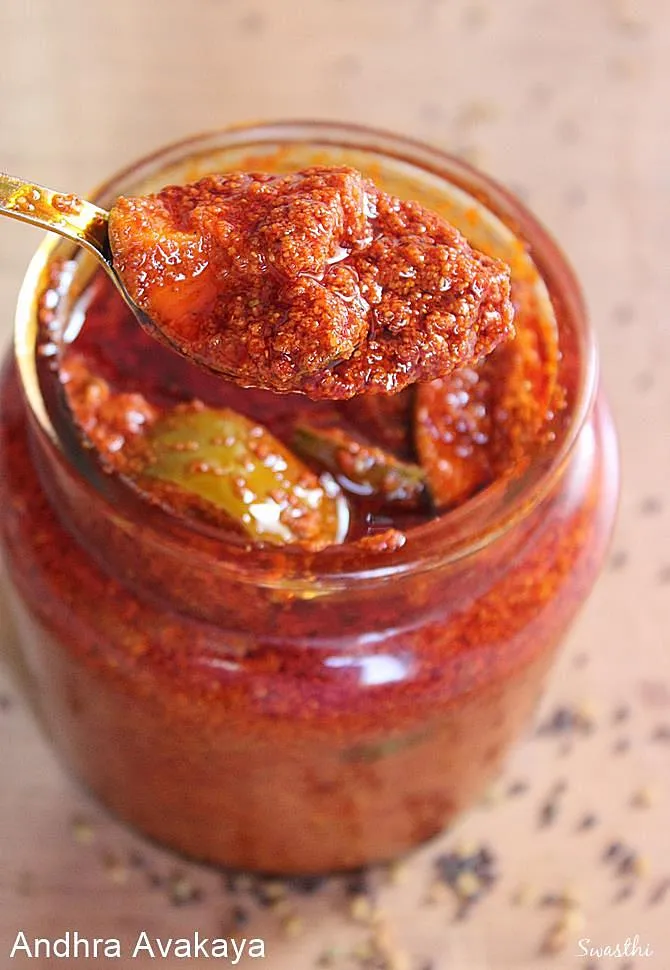
Photo Guide
Preparation for Avakaya
To make 1 to 2 days ahead
1. Wash ceramic jars known as Bharani or jaadi or glass bottles thoroughly with diluted dishwashing soap. Make sure no dirt, grease or grim exists. Rinse thoroughly a few times.
Sundry them well until they become hot. In case using glass bottle, make sure they are at least warm. Exposing them to hot sun for very long may also crack them.
After taking away from the sun, allow them to cool down completely so they don’t build up moisture inside. Cover and then set aside in a clean and dry cabinet/shelf.
2. Clean and then sun dry mustard seeds, crystal salt, methi seeds and red chili powder for few hours. This is done to ensure they are moist free. Transfer them to clean and dry jars. Set them in a dry place.
3. Wash thoroughly grinder/mixie jars, 2 large utensils/ mixing bowls, a measuring cup, few spoons, a bowl and 2 large and 2 small cotton clothes. Dry them very well to make sure they are free from moisture. Store these in a dry place.
Mango Cutter or Knife
4. The pickle variety mangoes are very hard and tough to cut them correctly. In most homes men cut these with the help of a special traditional cutter. This kind of mango cutters have a large wooden base and a iron blade cutter with a handle. These are easily available on amazon. It is good to have one if you are making avakai in large quantities.
Since I do not have this, my husband cut it with a large sharp knife. You will have to wash and sun dry the cutter or knife as well.
Note: Keep your nails trimmed, no polish, and no rings on your fingers for hygiene purpose. You will need to use clean and dry hands to mix the spice powders.
Using a ladle or a spoon may not be appropriate, especially if you make in large quantities.
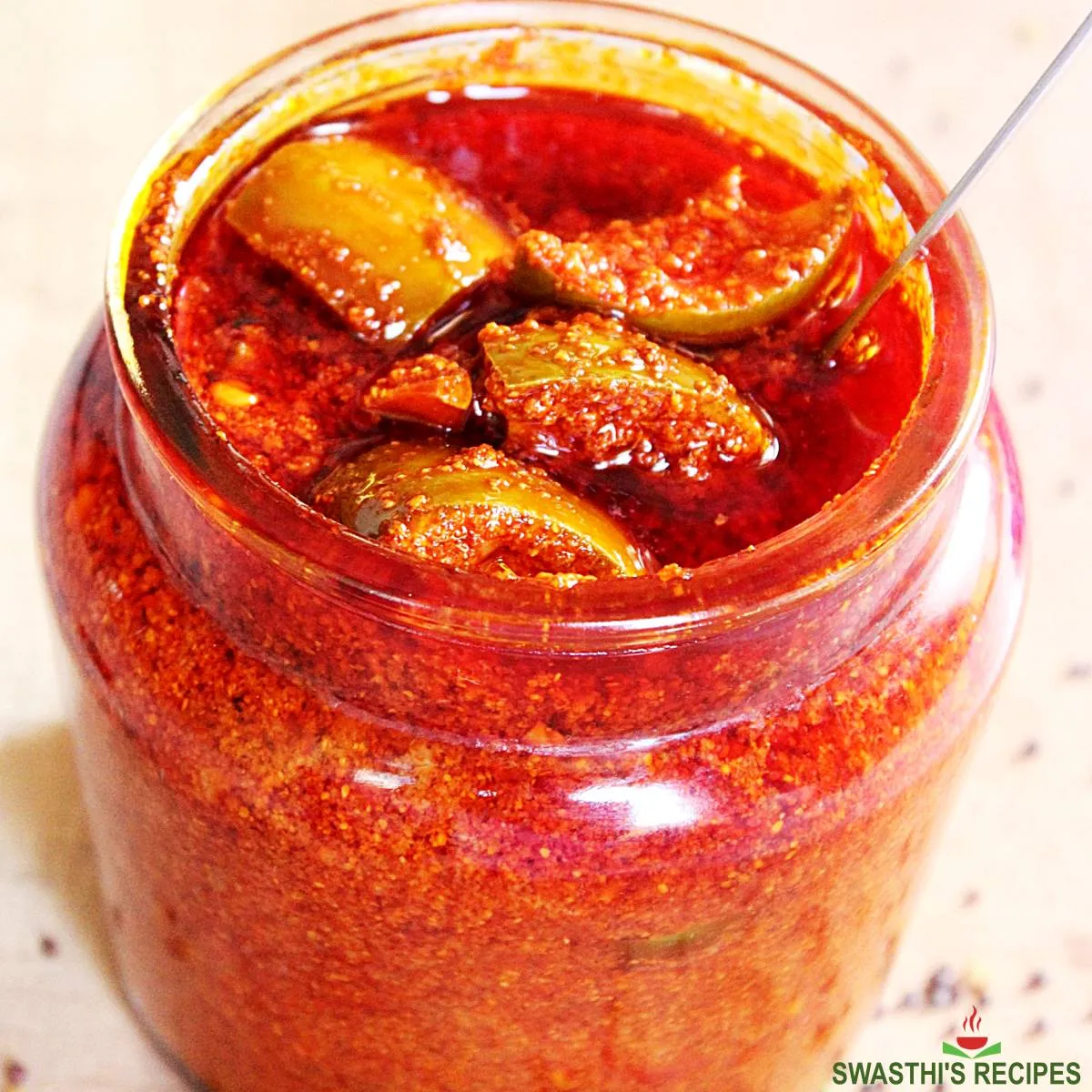
Choosing Mangoes for pickle
Traditionally people go to the mango farms/ trees where they choose and hand pluck the mature mangoes. Mangoes with bruises or those fallen off the tree are not used to pickle. These kind of mangoes will soften often quickly after pickling. This also changes the color and flavor of the pickle faster.
However people who do not have such options buy more mangoes than required and choose the best ones from those. Here is how to select the mangoes:
1. Choose fresh, sour, hard and mature raw mangoes. Special pickle variety mangoes are available in the market. They come in medium size and are dark green in color.
2. Mangoes that have fallen off the trees or the ones with bruises are not suitable to make avakaya. You may use them to make other recipes like Mango rice, Mango dal or this instant Mango pickle.
3. You can also make this mango pickle using any other good sour variety mangoes that are pulpy, but I guess the taste may change after 4 to 6 months.
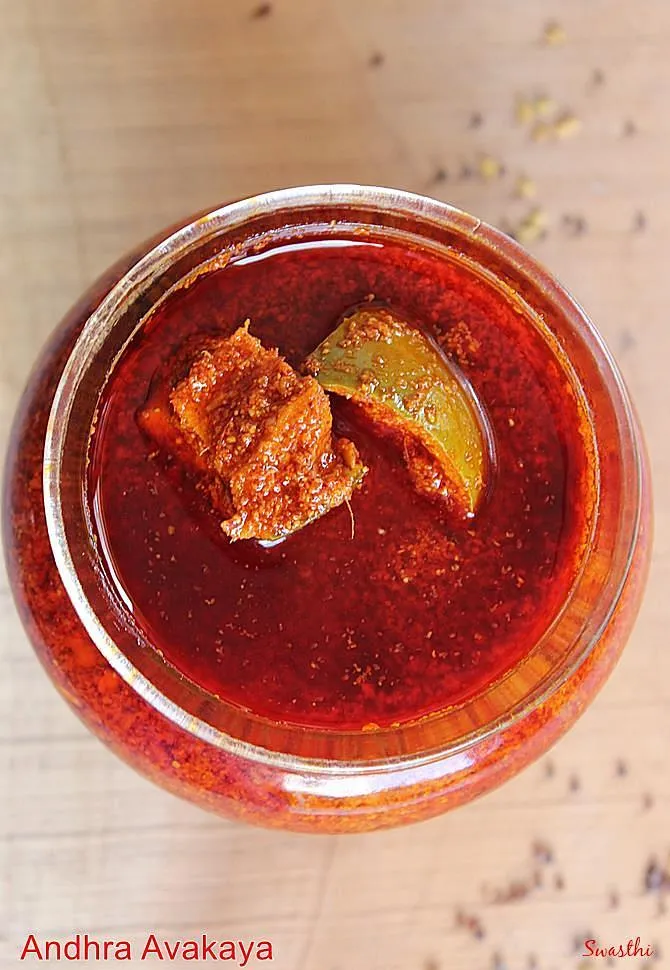
Related Recipes
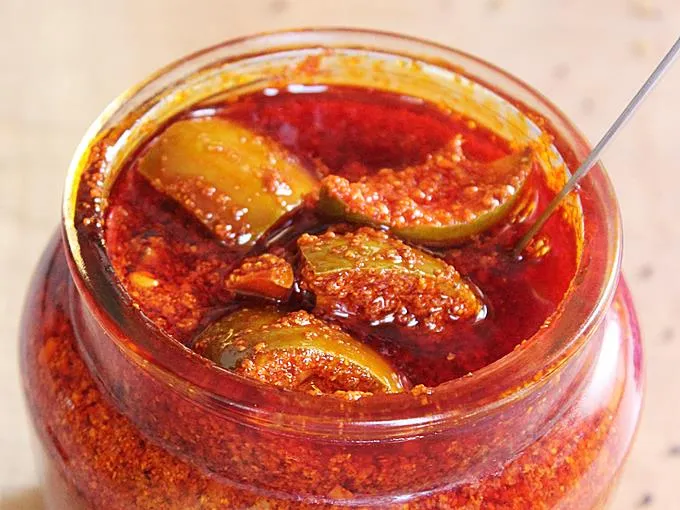
Recipe Card
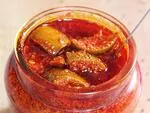
Avakaya Pachadi (Avakai Pickle)
For best results follow the step-by-step photos above the recipe card
Ingredients (US cup = 240ml )
- 4 to 6 cups cut mango pieces (refer notes)
- 2 cups oil
- 1 cup mustard powder
- 1 cup red chili powder (Low heat such as Byadgi or Kashmiri)
- ¾ cup crystal salt plus 2 tbsp
- 1½ teaspoon Methi powder or methi seeds (refer notes)
- ½ cup garlic or about 70 grams (refer notes)
Instructions
Preparation for avakaya pachadi
- Wash mangoes thoroughly and soak in a large wide pail or bucket for 1 hour. This is done to remove any dirt deposited on them.
- Remove them from water and allow to dry.
- Wipe them with a cloth and spread them on a large cotton cloth. They must be completely moisture free and dry.
Preparing the work area
- The place where you intend to make the pickle has to be absolutely clean, dry and free from moisture.
- Move the mangoes to this work area and all the preparation has to be done here to prevent spoilage. Get all the other things we prepared the previous day to this place . (Read the preparation part from the blog post)
- Remove any portions of stems still on the mangoes. Cut each mango to half, with the shell and kernel intact. Mango can also be wrapped in a cotton cloth and then halved to prevent slipping or injury. If the shell or the covering of the kernel gets separated from the pieces, they are not used for pickle since they turn soggy and the taste of the entire pickle changes.
- With the help of a spoon, remove the kernel and discard. You can also see a paper thin layer in between the kernel and the inner portion of the shell. Remove that as well. Use a spoon to remove that completely. Wipe off with a clean dry cloth.
- Cut each halved mango to 2 (quarters) and then further to 3 pieces each. This way a medium sized mango gets about 12 pieces. Make sure each piece also has a shell part on it.
- Measure & place these cut pieces on a cloth or utensil.
- Peel the garlic cloves. Make sure they don't have any green shoots at the base. Set them aside. We also crush lightly 10 garlic cloves. This is optional. If the garlic cloves turn green, do not use them.
- Powder the mustard seeds. Measure 1 cup and add it to a large dry utensil. Set aside the left over.
- Powder the methi seeds if using. Add this to the same utensil along with mustard powder.
- Powder the crystal salt. Measure ¾ cup plus 2 tbsp powdered salt and add it to the utensil. Also measure and add red chili powder, garlic. Mix all these.
Making avakaya or avakai
- Pour 1½ cups oil to another dry utensil. Dunk the mango pieces in the oil, a handful at one time. Take them off from the oil with a deep frying spatula or slotted spoon. Add them to the spice mix. Coat them well with spice powder and add it to the bharani/ glass jar.
- Repeat this process of dunking a handful of them in oil and then in the spice mix. Then to the bharani/ jaadi. Once you are done, there will no spice mix left. You may be short of oil for the last few batches. Then use up the rest of the half cup.
- When you are done with this, if you are left with oil or any spice powder, just add the spice powder and then pour the oil to the jar.
- Cover with a lid. Place a cotton cloth and then tie up with a cloth ribbon or a thin long piece of cloth, across the neck of the jar.
- Keep this in a dry cabinet/shelf for 3 full days. We wait for 72 hours.
- On the fourth day, open the lid and then mix up using a dry ladle. We use strong wooden ladles when made in large quantity.
- Taste the pickle and add little more salt if needed. Wait till the next day to check if there is a layer of oil floating on the pickle, if not add the rest of the oil.
- Do not skimp on the salt and oil, they act as natural preservatives to preserve pickle for a year. If there is not enough oil or salt, pickle may get spoilt.
Tips to follow for a good shelf life.
- Do not serve pickle directly from the jar especially if you have made in large quantity. Opening the jars frequently will diminish the quality, color and flavour of pickle. Always take a portions of this to another glass bottle for everyday use.
- Always use dry hands, ladles and spoons while handling the pickles. We usually heat them up a bit near the gas flame.
Notes
- Make sure your mangoes are very sour else the pickle won’t turn out good.
- Traditionally avakai pickle is made only with 4 cups of cut mango pieces which yields a lot of gravy / oota in Telugu. It is good for a family who eat lot of this hot and spicy gravy. We specifically in my Mom’s home do not eat so much of the gravy so we use 6 cups of pieces. So the proportion of gravy per piece of mango is less. To put in simple terms – “4 cups yields less mango pieces with more gravy, 5 to 6 cups yield more pieces with just a moderate amount of gravy”. My MIL and my other extended families prepare with 4 cups of pieces. I have eaten that as well. It tastes a bit more pungent and strong. It is up to you how much you want.
- You can use any cup size but make sure you use the same cup for measuring all the ingredients. If using more mangoes, use a larger cup or bowl to measure. You will have to increase the quantity of methi seeds proportionately. The quantity mentioned in the recipe is for a 240 ml cup.
- Same with garlic, 70 grams for 240 ml measurement. You can also use same cup used to measure mangoes – we need half cup garlic cloves. You can also reduce this slightly, this is on the higher side and this is want makes the pickle more fragrant.
- Traditionally a lot of people use a mix of Guntur hot chili and the regular medium hot chili powder. But at home we never use Guntur chili as it is extremely hot for our taste. We use byadgi chilli powder. If you want to use hot chilli powder, you may start with lesser quantity.
NUTRITION INFO (estimation only)
© Swasthi’s Recipes
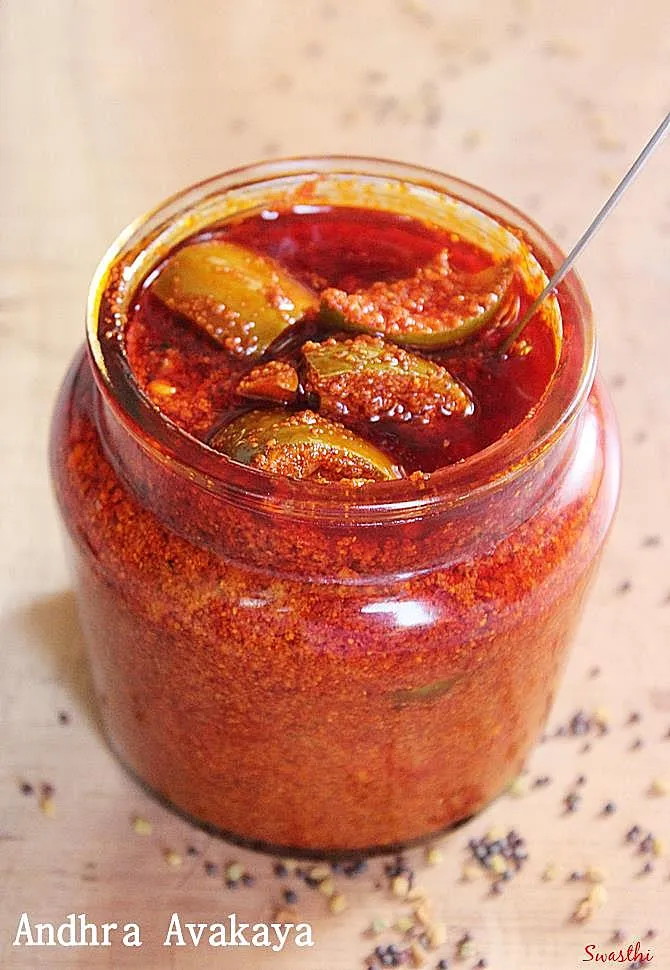
This post on Avakaya was first published in March 2016. Updated and republished in April 2023.
About Swasthi
I’m Swasthi Shreekanth, the recipe developer, food photographer & food writer behind Swasthi’s Recipes. My aim is to help you cook great Indian food with my time-tested recipes. After 2 decades of experience in practical Indian cooking I started this blog to help people cook better & more often at home. Whether you are a novice or an experienced cook I am sure Swasthi’s Recipes will assist you to enhance your cooking skills. More about me
Follow Swasthi’s Recipes


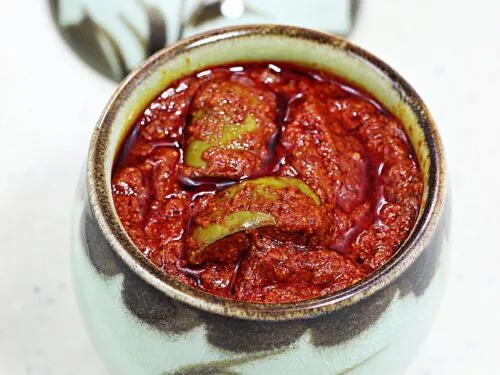
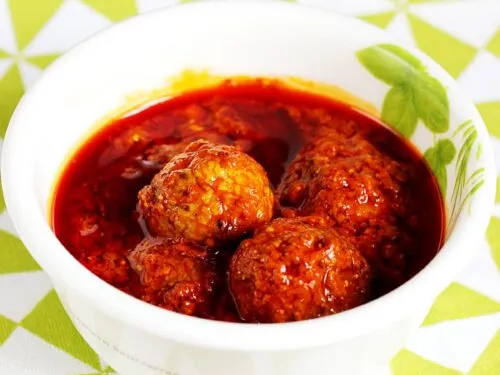
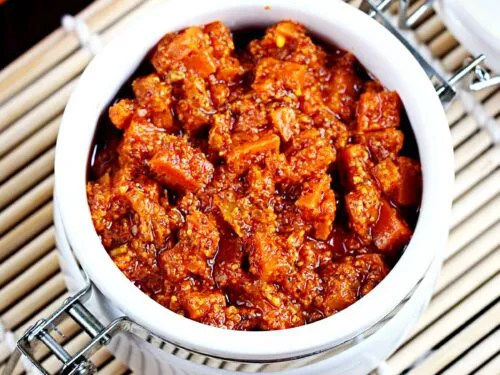
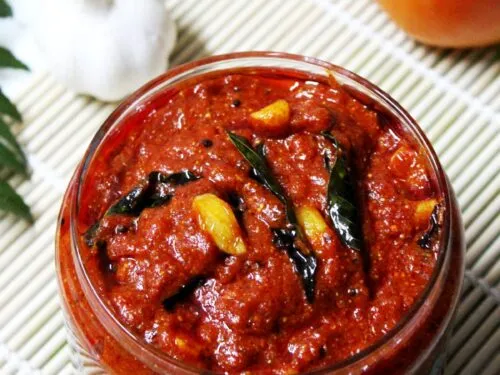
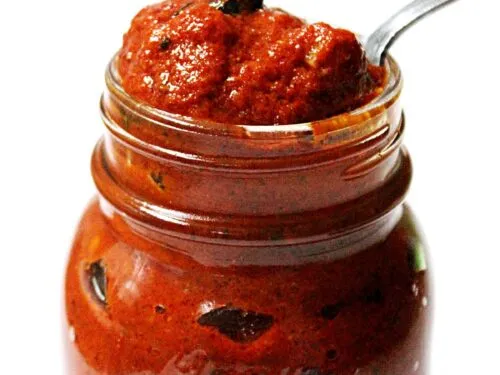
Comments
Please post Punjabi /North Indian pickles of green chillies / red chillies (fresh) ones and also of nimma kaya oorugayas.
Thank you for your recipe. I just made it..it’s been 3days now.should we keep it in sun.
This pickle is not kept in the sun. Rest it in a dry cabinet.
Thank you 😊
Thank you for your recipe. What mustard seeds should be used… yellow or black…
Hi Safira,
Use brown/black mustard
Good explanation..reminded my mother as she taken so much care for making this divine taste Avakaaya!
Thank you so much for sharing such a wonderful recipe.
How long should I wait before I can serve this pickle?
people start eating on the 4th day but it is still pungent. Wait at least for 7 to 8 days.
Thank you
The mangoe skin is still hard bu the taste is delicious. It’s been ten days, should I put it in the sun
Don’t keep in the sun
The mango skin is still hard, should I put it in the sun
Sudha, it is just right. It should remain hard and that’s why it keeps good for an year without getting mushy. It will take a few weeks to soften. We just eat it that way even if it is hard.
Thanks.
Very nice to learn new thins
Power salt shall i use. If ok mention the qty. Crystal salt means i should grind it..?
Hi, How much salt (in powdered form) to add depends on the brand. Saltiness differs from brand to brand and you can easily go wrong even if I give you an approximation. Traditional pickle is made by measuring crystal salt. If you have no option you may start with 1/3 cup salt (powdered form). Taste test and top up as required while mixing the spices.
Good morning
Could you kindly please assist me. I don’t know if the question ahas been asked or not already but can’t seem to find the answer in the comments. What is the difference between this recipe and the one written mango pickel. I want to make some to sell to friends and family but don’t know which one to use. Thank you for your assistance
Regards
Good Morning,
If it is for selling I would suggest this recipe and not mango pickle. The difference is this one has more oil, more spices and salt that act as preservative and the pickle won’t spoil if all the instructions are followed. My other recipe (mango pickle) is something we people make when the mango season has just begin, they are usually not so mature and not hard enough to withstand an year long fermentation. We make a few batches of that when the mango season arrives and finish up in a few months. However this pickle is pungent and hot compared to the other. I would suggest you try with a small batch first to test if you like it. Hope this helps.
Thanks for the recipe madam. My avakkai turned out to be salty. How do. I rectify the mistake?-
Hi Vaijayanthi,
How many days is it now? After 4 days the saltiness will begin to reduce. You can wait for a few more days and see. You can also add more mangoes pieces as they absorb the excess salt. A reader just shared in the comments below that adding grated mangoes reduces the excess salt. Hope this helps
Madam.. thanks for your recipe. However my avakai turned out to be more salty .. how do I adjust it.pl reply
I used Tata namak
Mam I liked all your recipies But if you give the measurements in grams, then it will be more perfect to follow. Kindly requesting you to give the measurement in grams along with cup measurement. Thanking you.?
Hi Manjula,
This is a traditional recipe to make avakaya. The ingredients are not weighed but measured in cups. If making in large quantity use a large bowl. I have given the details in the post. That is how it is made.
If I add mustard and methi powder in big quantity mistakenly it turns bitterness what is the solution to adjust the taste
Hi Sujani,
Add more amount of the other ingredients as well (except methi and mustard). It will turn out perfect if you follow the same proportions as mentioned in the recipe.
Thanks I make this avakaya every year using this recipe. Comes out fantastic. I start with lesser salt and top up more on the 3rd day.
Glad to know Usha. Thank you for letting me know!
What is the oil being used in preparing Avakaya…….It’s not a top secret……I have used Olive POil, Canola oil, Rice bran oil….the right oil gives the Avakaya it’s charactreristic taste and flavour…
I am a confessed foodie and cook….like to experiment..
Hi Sundar,
You have used all wrong kinds of oil. Traditionally sesame oil or peanut oil is used for avakaya, more importantly cold pressed oil (extracted through wooden ghani) was used which is the actual secret that enhanced the flavor of the pickle. It is also unrefined so the flavor is more intense. Hope this helps
Hi, can I use mustard oil?
Yes you can
Thank you for your prompt feedback. However, can’t find the images over recipe card? also do you have any video?
Yes! I don’t have images and video for this recipe.
4 cups of raw mangoes pieces so how many raw mangoes of medium size should i purchase to make them cut
3 large mangoes should yield you about 4 to 5 cups.
plz tell me can i add hing powder to thz if yes tell me how much
We don’t add hing to this pickle. Not sure how it will taste.
plz tell me for 4 cup pieces how many raw mangoes of medium size should i take
can i add hing in thz if yes how much hing should i add to make my pickles more taste
Hi Swathi, I got recipes I wanted, mango and amla pickle. Thanks.
Which oil to use in both pickles ? Is it mustard oil or groundnut oil ?
Curiously waiting for clarification.
Hi,
You can use any but use refined oil. Both will work. Don’t use kachi ghani mustard for this.
Hi Swasthi
Can you advice on variety of mango to be used for this pickle and what is it called in tamil.
Hi Fathima,
Don’t make pickle during this time. It will turn moldy within a few days. I don’t know what they are called in Tamil. They are dark green in color and hard to touch and cut as well. I will update the post if I am able to find those mangoes here. Hope this helps.
Thanks Swasthi for your help.Will follow your advice.
Hello Swasthi! What an amazing recipe! I make an instant mango and carrot pickle but wanted to make one which keeps for a year or more without having to put in the fridge and ive been wanting to sell it bc my instant recipe is similar to urs and very tasty! Ive followed this recipe however i made a mistake and used the oil warm/hot, extra virgin olive oil (but i dont know of cold pressed). Will this affect the recipe and cause spoilage?
Also I wanted to process the jars to ensure shelf life (ie use a water bath to can them). What are your thoughts?
Thank you so much for your time!
Hi Sultana,
Thank you! It should be fine. I have never made this with hot/warm oil. I also have no idea about water bath. I have shared all my thoughts in this post regarding the shelf life & how to store it. This is how it is made in India and it keeps good for not just 1 year but even for 2 years. I will reply your email in detail on your other queries. Hope this helps